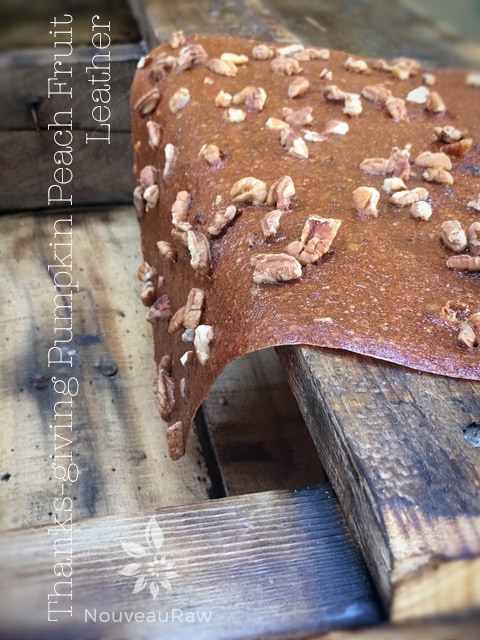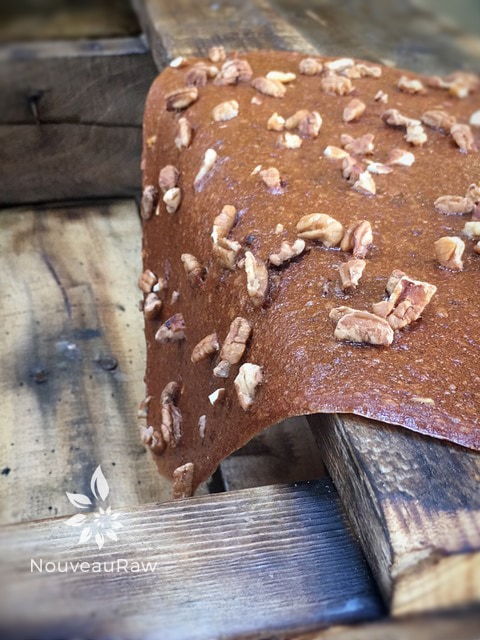Thanks-giving Pumpkin Peach Fruit Leather

 Add to favorites
Add to favorites

~ raw, vegan, gluten-free ~
The inspiration for this leather came from my latest trip to a fruit stand that is along what they call the “Fruit Loop” here where I live. There are 30 farms/orchards that have fruit stands that you can visit throughout the summer. They sell, fruit, veggies, homemade jams, and many other wonderful treats made from the local produce. One day…Oldfather Farms will be on the Fruit Loop! :)
During my visit to the fruit stand, I got to chatting with one of the workers, and I asked her what they did with the fruits that were too ripe to sell or were perhaps “deformed.” She said they set them aside in the back walk-in coolers and sell them as what they call, seconds. She said they get people who come in looking for overly ripe fruit to can.
My eyes got big and bright as my mind immediately started formulating recipes! I asked her if they had any on hand and she said…”Follow me.” I was so giddy as I made my selection and we both walked out carrying 2 cases of fruit. Let me put this in better perspective because I still can’t believe that I got such a good deal.
A 1/2 flat of peaches was selling for $12.00. They were all snuggled individually in the box. They were all the same size and color. They were beautiful. My case of “seconds” (not 1/2 flat, but a CASE) was sold to me for $10.00!!! They were all snuggled up with one another; they ranged in size, color, and many hand deformities.
When I say deformities, an example would be that when the peach or fruit was growing, it was resting on a branch, therefore an indentation was grown into it. Now, some did have bruises, and 90% were in need of instant processing, but for what I needed for (leathers) they were a gold find!! The pictures below are ones that I took of my so-called “second” peaches and apricots. I couldn’t be any happier! Next time you visit your local farmers market or if you have fruit stands near you, don’t be afraid to ask if they have any “seconds.” :) So, that is why I named this leather Thank-giving Pumpkin Peach Fruit Leather. I am giving thanks for this blessed fruit!
Before we get started, I wanted to let you know that I peeled my peaches. I didn’t mean to, and you don’t have to, but I thought it was only fair to tell you exactly how I made this recipe. Lol, What happened was, I was washing the peaches when my husband called me. We were both in a chatty mood and as I got caught in conversation with this lovely man… without thought started peeling the peaches… I found it so easy to remove the skins and I was having fun with it. I am strange that way. haha. By the end of our talk, I had peeled them all! Now mind you, these peaches were very ripe so the skins about undressed themselves. I quickly grabbed a snapshot of how I peel them, just in case you are new to this.
Starting from the left: peach #1 – that is a whole peach, nothing is done to it other than I washed it. Peach #2 – I slide the knife around the peach, down to the pit on both sides. Peach #3 – grabbing the corner of the peach skin at the top, I simply peeled the skin back and off. #4 – I made one other cut in between the already made cuts and the wedges just popped out as shown in the picture. Easy-peasy!
 Ingredients:
Ingredients:
yields 4 cups puree (made 12 gift pkgs)
Puree:
- 5 cups sliced peaches
- 3/4 cup pumpkin puree (canned or fresh puree)
- 2 Tbsp maple syrup
- 1 tsp ground Ceylon cinnamon
Topping:
- 1 cup whole, raw pecans, chopped
- 2 tsp raw coconut crystals
- 1/2 tsp ground Ceylon cinnamon
- spray coconut oil
Preparation:
- Topping – On the cutting board, chop the pecans into small pieces. Lightly coat them with the spray coconut oil. Sprinkle them with the coconut crystals and cinnamon. With your hands, toss the pecans to coat them. Set aside.
- Select RIPE or slightly overripe peaches that have reached a peak in color, texture, and flavor.
- Prepare the peaches; wash, dry, and remove stones
- Puree the peaches, pumpkin, maple syrup, and cinnamon, in the blender or food processor until smooth.
- Taste and sweeten if more is needed. Keep in mind that flavors will intensify as they dehydrate.
- When adding a sweetener do so a little at a time, and reblend, tasting until it is at the desired taste.
- It is best to use a liquid type sweetener. Don’t use granulated sugar because it tends to change the texture.
- Spread the fruit puree on teflex sheets that come with your dehydrator. Pour the puree to create an even depth of 1/8 to 1/4 inch. If you don’t have teflex sheets for the trays, you can line your trays with plastic wrap or parchment paper. Do not use wax paper or aluminum foil.
- Lightly coat the food dehydrator plastic sheets or wrap with a cooking spray, I use coconut oil that comes in a spray.
- When spreading the puree on the liner, allow about an inch of space between the mixture and the outside edge. The fruit leather mixture will spread out as it dries, so it needs a little room to allow for this expansion.
- Be sure to spread the puree evenly on your drying tray. When spreading the puree mixture, try tilting and shaking the tray to help it distribute more evenly. Also, it is a good idea to rotate your trays throughout the drying period. This will help assure that the leathers dry evenly.
- Sprinkle the sweetened pecans on top of the wet leather.
- Dehydrate the fruit leather at 145 degrees (F) for 1 hour, reduce temp to 115 degrees (F) and continue drying for about 16 (+/-) hours. Flip the leather over about halfway through, remove the teflex sheet, and continue drying on the mesh sheet. The finished consistency should be pliable and easy to roll.
- Check for dark spots on top of the fruit leather. If dark spots can be seen it is a sign that it is not completely dry.
- Press down on the fruit leather with a finger. If no indentation is visible or if it is no longer tacky to the touch, the fruit leather is dry and can be removed from the dehydrator.
- Peel the leather from the dehydrator trays or parchment paper. If it peels away easily and holds its shape after peeling, it is dry. If it is still sticking or loses its shape after peeling, it needs further drying.
- Under-dried fruit leather will not keep; it will mold. Over-dried fruit leather will become hard and crack, although it will still be edible and will keep for a long time
- Storage: To store the finished fruit leather…
- Allow the leather to cool before wrapping up to avoid moisture from forming, thus giving it a breeding ground for molds.
- Roll them up and wrap them tightly with plastic wrap. Click (here) to see photos of how I wrap them.
- Place in an air-tight container, and store in a dry, dark place. (Light will cause the fruit leather to discolor.)
- The fruit leather will keep at room temperature for one month, or in a freezer for up to one year.
Culinary Explanations:
- Why do I start the dehydrator at 145 degrees (F)? Click (here) to learn the reason behind this.
- When working with fresh ingredients, it is important to taste test as you build a recipe. Learn why (here).
- Don’t own a dehydrator? Learn how to use your oven (here). I do however truly believe that it is a worthwhile investment. Click (here) to learn what I use.
© AmieSue.com
Tags: Dairy Free, Gluten Free, Nut Free, Refined Sugar Free, Soy Free, sugar free



 Add to favorites
Add to favorites
 Ingredients:
Ingredients:
I made a fruit leather. I Love it.The favor was the grave with banana and chia.